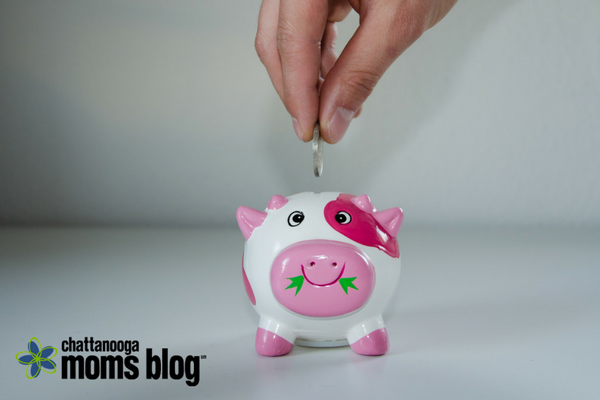
Remember when I said shopping was America’s national pastime? Remember buying those matching Christmas pajamas that won’t fit your kids next year? And the toys now sitting in a corner?
Well friends, it’s time to make a little cash from that closet stash. Get your spring cleaning game on and start selling your unused, unworn, taking-up-too-much-space stuff. Katie’s already given you tips for buying clothes for your ever-growing kids right here.
Now I’m going to tell you where to sell those shoes they’ll outgrow in 90 days (true story).
1. CONSIGN IT
Consignment stores generally give you cash directly for your items, before they resell them. Ask ahead of time to see what items they accept.
Fees: None really, but don’t be fooled. The store isn’t going to hand over the cash that your item is actually worth. They also want to make a profit. You will get far less than the resale value.
Pros: You don’t have to tag or price your items. The staff gives you a quote for your stuff and hopefully more cash than you’re expecting (aim low).
Cons: Stores can be picky about what they take and you may not get as much money as you would at a seasonal sale.
Chattanooga consignment stores:
Kid to Kid
Once Upon a Child
Plato’s Closet (teens and young adult)
Style Encore (women’s casual and business clothing)
Encore Consignment Boutique (higher end women’s fashion)
If you’re raising a reader (or a gamer), or simply need to offload a dozen DVDs you never watch, McKay’s is the place to sell your books, games and electronics for cash or store credit.
Seasonal consignment sales often run in the spring and fall for only a few days to a week. You price and tag your items, drop everything off, and then pick up (or donate) whatever doesn’t sell after the sale.
Fees: Generally a nominal fee to register, and then you get to keep about 70% of what you sell. Some sales let you work multiple volunteer shifts to net another 5-10% profit. Factor in supplies you’ll need: hangers, safety pins, index cards, labels and highlighters. For an extra fee, you can even have someone else tag your stuff!
Pros: You can set your own price, but remember you want your item to sell. Consigners generally get early shopping passes to the sale — volunteers can shop even earlier. Seasonal sales often accept a much larger selection of items than consignment stores.
Cons: It’s a lot of work. Safety pinning 200 baby items to hangers isn’t for the faint of heart.
Pro Tip: If you have the space, keep your unsold tagged items for the next sale.
Local seasonal consignment sales:
Duck, Duck, Goose (only remaining Spring sale left this season!)
Just Between Friends
Rhea Lanas
2. SOCIAL MEDIA
Facebook Marketplace can be super easy, or super sleazy. I really only recommend selling on here if your item is too large to ship — like furniture. Fellow blogger Elizabeth quickly sold multiple large items (think appliances) over the course of a few days. The Sailor even bought a used truck on there! I found vintage Pyrex antique dealers and met them nearly an hour away to offload a trunk full of dishware for cash.
Fees: None, but you do need a Facebook account, so there’s that.
Pros: No shipping costs when used locally.
Cons: People can be no-shows and downright rude.
Pro tip: Meet in a safe public place and specify exact cash.
Other similar local sites:
Letgo
OfferUp
Varage
Facebook BST (Buy, Sell, Trade) groups cater to specific brands or items and may have more privacy settings than Marketplace. They may not be local, so shipping could be involved.
Pros: You may be able to shift those matching Lily Pulitzer Easter dresses much faster.
Cons: Some groups are extremely picky about how an item is listed. You may find your listing deleted before it even has a chance to sell. Read and adhere to the rules within each group.
A cautionary word on purchasing items: Use PayPal ‘Goods and Services’ to buy anything on a Facebook BST group if you’re not meeting in person to acquire the goods. Do NOT use ‘Friends and Family’ through PayPal unless you actually know the person. If you’re swindled out of your money, PayPal only covers you through Goods and Services. Many sellers tell you they prefer Friends and Family because they are charged a nominal fee otherwise. If you’re a seller, suck up the surcharge and accept payment from Goods and Services.
3. SELL AND SHIP ONLINE
Online auction giant eBay has been around since 1995, so clearly they’re doing something right. List items in Auction style, or Buy it Now, or a combo of the two. Peruse the site to see similar items that already sold to price accordingly (eBay gives you recommended prices for your listing, too). You can also give buyers the option to make an offer, which you can then accept, decline or counteroffer.
Fees: eBay offers 50 free listings a month — after that there is a 30 cent fee per item listed. Roughly 10% of your earnings are kept as final value fees, depending on the category of item sold. Unless you offer free shipping, buyers pay the actual shipping cost or a cost you specify, but eBay still takes a small percentage of that too. However, they do give you a discount on purchasing shipping labels directly from them. More info on eBay’s fees can be found here.
Pros: You can sell almost anything on there. I have sold dishes, knitting needles, clothing, shoes, bags (so. many. bags.) jewelry and even a lone cap to a specialized water bottle.
Cons: There are a lot of details to add in a listing. Good for buyers, but more work for you. Preview and proof your listing before making it live. Shipping can also be confusing. I recommend charging the actual shipping price (weigh and measure the item, packed, before listing it) or offer free shipping and absorb the cost of it into the price of the product.
Pro tip: Order your mailing supplies through USPS. Many USPS boxes and envelopes are FREE! Spend less time schlepping through the garage for the right size box, and more time listing your stuff.
Mercari is similar to eBay since you can sell more than just clothing with a flat 10% fee for sold items. No listing fees.
Poshmark is a clothing paradise. Create a profile and upload photos with a brief description to sell items from your online ‘closet.’ Photos are styled with more flare on here, plus sellers should package goods neatly, with a note for the buyer. Fees run 20%. Shipping labels are emailed to you directly from Poshmark. If you’re a social media maven, you’ll enjoy following other fashionistas and ‘sharing’ items. Offers are also popular on this site, as are trades. If you’re selling and not open to offers or trades, state that the price is firm in the listing. Sellers also have the option to give private discounts to potential buyers who ‘like’ their item.
Tradesy offers very high end clothing, so unless your kid is wearing Gucci rainboots, you may want to just browse.
As a general rule, if your item isn’t selling for a while, try lowering the price, taking better photos, changing up the listing, or trying a new method. If something doesn’t sell after that, donate it, or host a clothing swap.


















